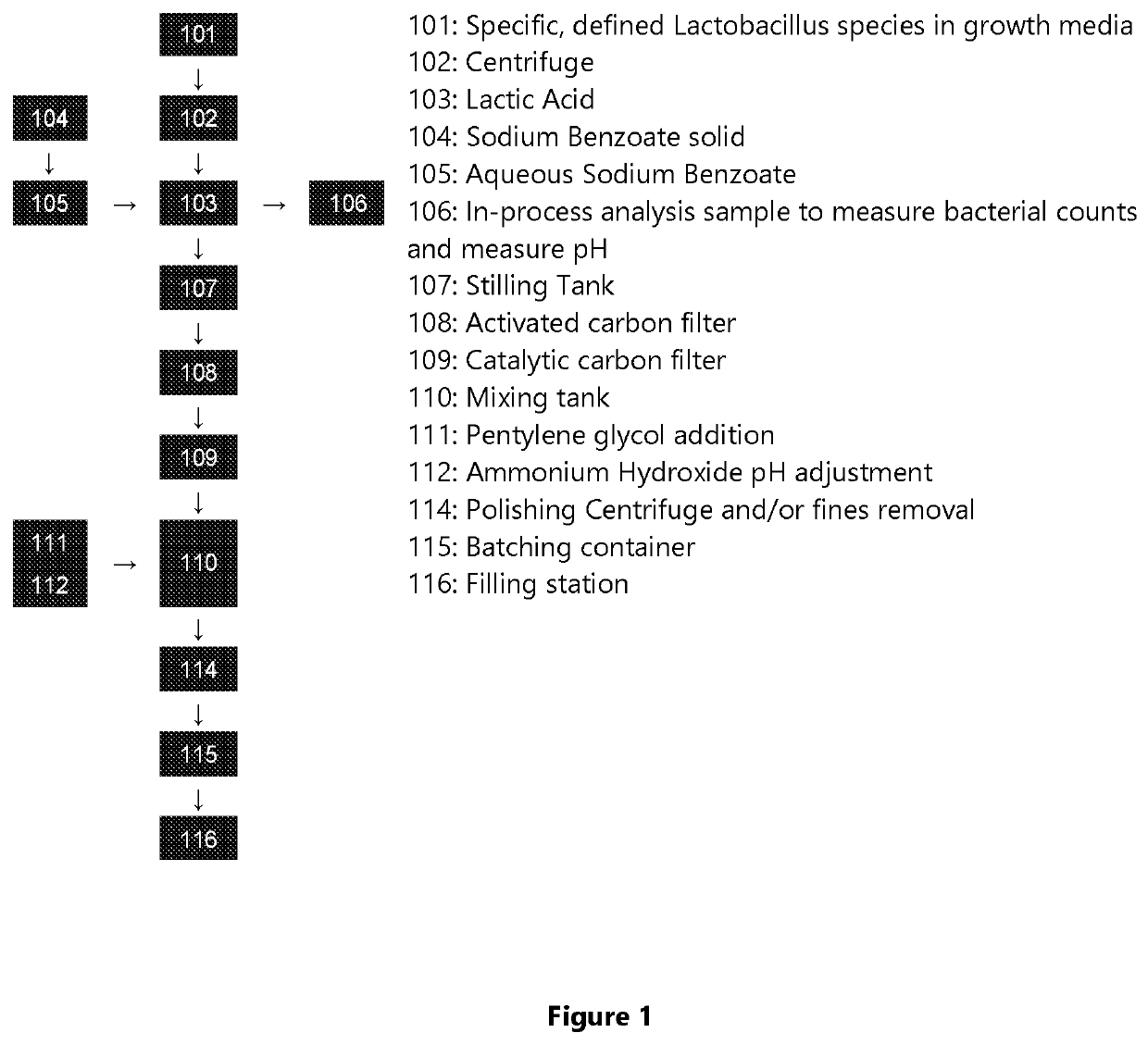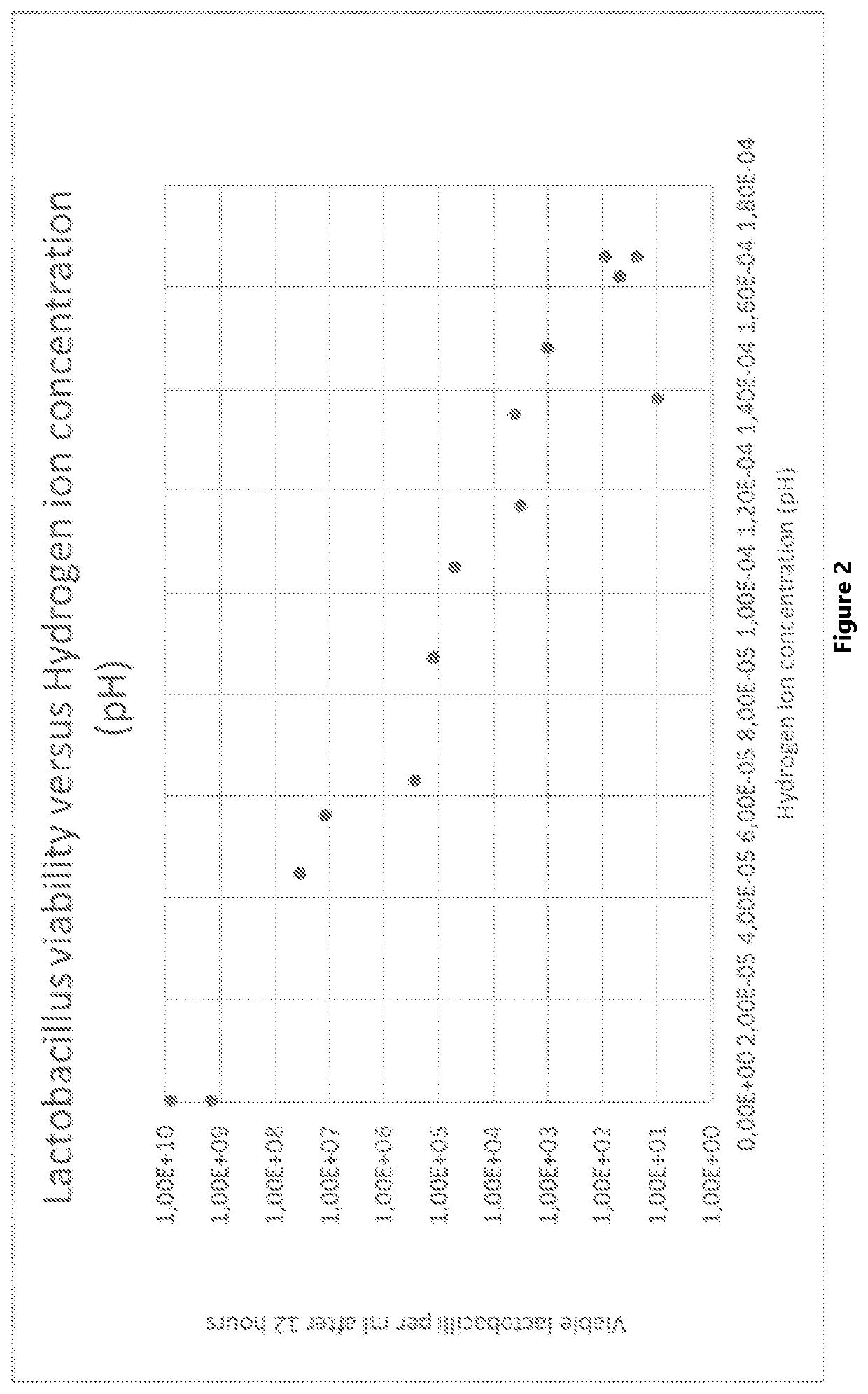Novel bacterial ferment of lactobacillus species
- Summary
- Abstract
- Description
- Claims
- Application Information
AI Technical Summary
Benefits of technology
Problems solved by technology
Method used
Image
Examples
examples 1
[0164]Lactobacillus plantarum was inoculated from a 1 ml frozen seed stock and grown under sterile, aseptic conditions at 37 centigrade in 1liter growth medium, then transferred to 400-liter intermediate growth medium after 24 hours and then transferred to a 5000 liter culture vessel after a subsequent phase of growth at 24 hours. The bacterial growth medium consisted of a blend of yeast extract, yeast peptone, sodium acetate, dextrose, sucrose, ammonium citrate, potassium phosphate, ascorbic acid, L-cysteine, magnesium sulfate, tween-80 and water. 5000 litres of a light brown, pungent smelling, growth media containing Lactobacillus plantarum that had just reached the stationary growth phase was separated by centrifugation in a sterile disc stack centrifuge. The supernatant from the centrifugation step was depleted of bacteria, however it still contained 3,500,000 lactobacilli per ml. Sodium benzoate was added during the collection process to a final concentration of 0.5%. Then, 70 ...
examples 2
[0165]Lactobacillus gasseri was inoculated from a 1 ml frozen seed stock and grown under sterile, aseptic conditions at 37 centigrade in 1liter growth medium, then transferred to 400 liter intermediate growth medium after 24 hours and then transferred to a 5000 liter culture vessel after a subsequent phase of growth at 24 hours. The bacterial growth medium consisted of a blend of yeast extract, yeast peptone, sodium acetate, dextrose, sucrose, ammonium citrate, potassium phosphate, ascorbic acid, L-cysteine, magnesium sulfate, tween-80 and water. 5000 liters of a dark brown, pungent smelling, growth media containing Lactobacillus gasseri that had just reached the stationary growth phase was separated by centrifugation in a sterile disc stack centrifuge. The supernatant from the centrifugation step was depleted of bacteria, however it still contained 1,500,000 lactobacilli per ml. Sodium benzoate was added during the collection process to a final concentration of 0.5%. Then, 70 liter...
examples 3
[0166]The following bacterial strains were prepared under sterile conditions and grown individually each at a scale of 5000-liter fermentation: Lactobacillus acidophilus, Lactobacillus casei, Lactobacillus fermenturn, Lactobacillus gasseri, Lactobacillus helveticus, Lactobacillus paracasei, Lactobacillus plantarum, Lactobacillus reuteri, Lactobacillus rhamnosus, Lactobacillus sakei and Lactobacillus salivarius. Each strain was harvested individually by sterile centrifugation and the supernatant was treated with 0.5% sodium benzoate and ‘shocked’ with 5-8% lactic acid addition, followed by incubation at room temperature for 24 hours. The treated culture supernatant mixtures were then blended together to reach a specific colour hue specification of yellow. This mixture was then passed through an activated carbon filter, this carbon treated mixture was then passed through a catalytic carbon filter. An aqueous mixture of pentylene glycol was added to the mixture to reach a final concent...
PUM
 Login to View More
Login to View More Abstract
Description
Claims
Application Information
 Login to View More
Login to View More - R&D
- Intellectual Property
- Life Sciences
- Materials
- Tech Scout
- Unparalleled Data Quality
- Higher Quality Content
- 60% Fewer Hallucinations
Browse by: Latest US Patents, China's latest patents, Technical Efficacy Thesaurus, Application Domain, Technology Topic, Popular Technical Reports.
© 2025 PatSnap. All rights reserved.Legal|Privacy policy|Modern Slavery Act Transparency Statement|Sitemap|About US| Contact US: help@patsnap.com



